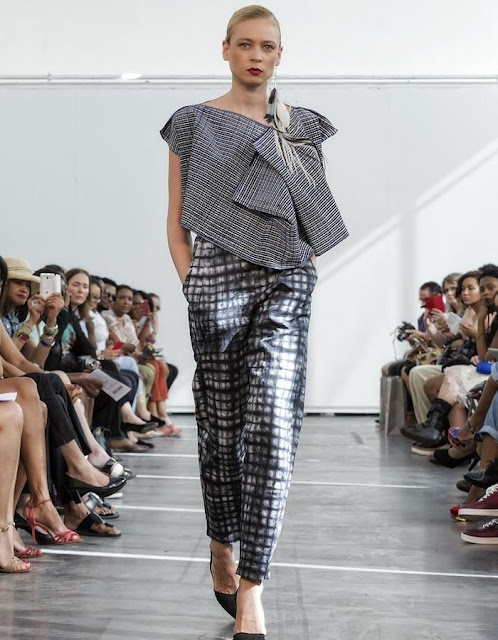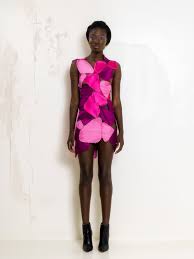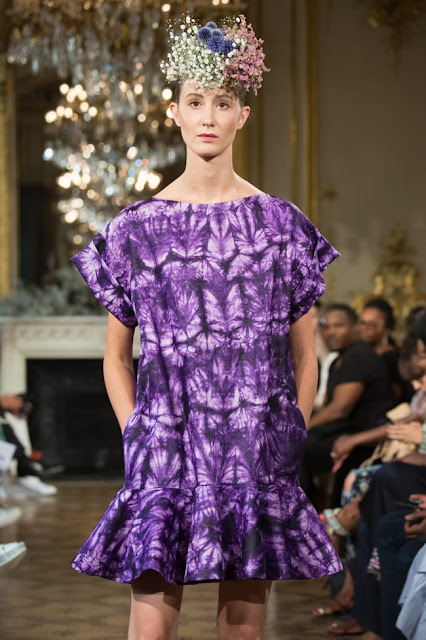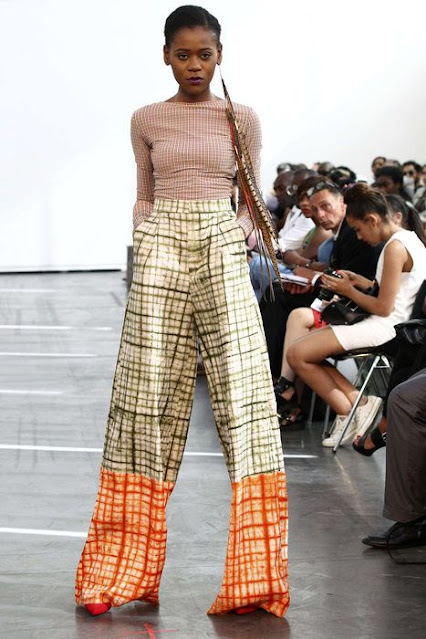Today's trendy tie-dye is yesterday's Adire. A textile with distinctly unique handmade patterns that never fails captures ones attention. In early 2019, this textile made a huge comeback. Not that it really went anywhere to be honest.
In my humble opinion, it has simply been overlooked. And one reason being that, it is synonymous with hippies, the very casual, used for interior decoration or maybe some old school of thoughts that says, "It was manufactured for the poor" so, trying to make it very mainstream often looks like a struggle.
Anytime it makes a comeback, each new fashion take dies a death. Designers in Africa are not helping either save a few. It only appears when it looks like they can create something eye catching to make quick turnovers. (Somebody correct me if I am wrong). However, we should not fail to give accolades to Chief Nike Davies-Okundaiye who has over the years been doing her best to preserve and promote the art of Adire and batik making through her arts and designs.
Tie-dye has been in production for many centuries all over the world. In Japan it is called Shibori, the Yoruba tribe of Nigeria call it Adire, members of the Wolof tribe call it chuupp while in the Cameroons it is referred to as Mon Marie est Capable. (My husband can afford it) a very expensive and slow technique, making it quite pricey. It is said with humour that only husbands with deep pockets and unwavering love for their wives buys it for them.
One man who is championing the use of authentic African textiles in the world of Haute Couture is Imane Ayissi. The tie-dye fabric is among the many almost forgotten original fabrics from Africa he uses for creating his Couture pieces.
As a designer, the need to change the narrative that today's popular wax prints are a true representation of Africa's historical creativity when it comes to textiles, is very important to him which is why he never uses them for any of his creations.
Historically the origins of the Dutch wax (Ankara) have been traced to Bali. The print patterns became popular in the African continent when it was brought back by African soldiers who went to fight in the Dutch wars. Its vibrant designs caught on and became much sought after, giving the Europeans a business opportunity to start mass production after learning the skills from the natives in Bali. They then cleverly added African motifs. This is what has morphed into today's Hollandaise etc. as the story goes. (Please Google).
For a witty designer like Imaye Ayissi whose agenda is to project in a positive light, authentic textiles from different parts of Africa, Ankara has no place in his creations. He intends to keep it pure and unadulterated. Being one of only three African designers to have been accepted into the Federation de la Haute Couture et de la mode (FHCM) since its inception, he is doing that brilliantly.
In his interview with Vogue magazine, he stated that he has a mission to show the world how hugely diverse African culture is. In his words, "Africa is not a country but a continent “One country alone e.g. Cameroon has over 200 spoken dialects "A profound complexity” which he intends to celebrate.
As it is evident today, no one community has the same norms and traditions 100%. There is always a difference no matter how minute, which is what, adds to their uniqueness. Something Mr. Ayissi is incorporating in his creations, telling one community story at a time using these textiles as a medium through his intricate designs.
To be accepted as a guest to show at the FHCM, you must stand out. Your creations have to be exceptionally unique. More like, something never seen before. Imane Ayissi's creations are all that and more, creating a modern complex and sophisticated vision of Africa according to Vogue.
One thing I realised as fashion designer back in Nigeria, was that creating a one-off outfit is one aspect, but designing with unique fabrics that are hard to find adds a certain kind of pizzaz and originality to your pieces. Mr Ayissi's idea of revisiting old traditional African textiles is just on a level I find quite intriguing. The ability to apply his Haute Couture knowledge in creating outstanding outfits out of textiles like Adire, Kente Aso-Oke etc. is quite remarkable.
Amidst the COVID pandemic Imane Ayissi showcased a collection made entirely out of scraps of fabrics. It was Entitled Amal-Si a Ewondo saying from the Cameroons meaning the great misfortune that befalls the earth. This reduced autumn/winter 20-21 collection pays homage to Africa our resilience cleverness and frugality. It also opened up the conversation within him, the point of fashion in relation to the coronavirus pandemic? Fashion is known to contribute terribly to the world's environmental waste problems. What is the point in making new clothes when all what people are thinking of right now is how to survive? Added to the fact that shops are filled with yet unsold clothes? (Source: Fashion United)
"Amal Si" is an answer to those questions. Through this medium, he has painted the perfect picture representing the average African attitude to life. Making the best of whatever situation we find ourselves in. Simply put, "Turning scraps to gold".
Imane Ayissi has given previously unknown or dying original textiles from different parts of Africa a grand awakening. He has taken this unique craftsmanship to the pinnacle of fashion which is Haute Couture. Showcasing them through his designs to an even wider audience where they should be highly appreciated.
For me, the question now is, how can these textiles be introduced into the everyday high street fashion? How can the average African designer benefit from creating with these textiles, How do you make such textiles into affordable garments that is worn and celebrated at the same level as the Ankara wax print?
One suggestion I believe could be that Imane Ayissi should collaborate at some point in the future with one or more high street brands at different times creating affordable lines for them with his message at the heart of collection. His pieces should appeal to the youths. Timeless creations that would be cherished for a long time because of the story it brings with it. This is only my humble opinion.
Imane Ayissi was born in Cameroon. He comes from an artistic and sporting family. His mother was the first crowned Miss Cameroun in 1960 after the country gained independence. His father was a champion boxer, while his siblings were dancers and singers.
Before branching out to start his own label in 2004, Mr Ayissi himself was a member of the Ballet National du Cameroun, he was also a model who was often seen on the catwalks of big luxury brands like Dior, Pierre Cardin, Givenchy, Yves Saint Laurent, and Valentino. Mr Ayissi's designs have been worn by Angela Bassett, Zendaya and many others.
Today Imane Ayisi lives in France where he continues to create. As a designer who is very sensitive about the environment, he tries to minimize the impact his designing leaves on the environment negatively a very positive attitude that is worth emulating.
(Written with permission from the designer)





























0 Comments